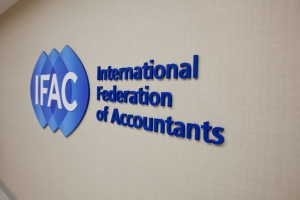عرض العناصر حسب علامة : الحوكمة
رسالة ماجستير: العلاقة بين آليات حوكمة الشركات ومستوى الإفصاح الإختياري وتأثيرها التفاعلي على الأداء بالشركة
إستهدفت الدراسة إختبار أثر آليات الحوکمة علي الإفصاح الاختياري وفحص العلاقة التفاعلية بينهما في التأثير علي الأداء (تکاملية / إستبدالية / مستقلة) بالتطبيق علي (30) شرکة مقيدة في سوق الأسهم السعودي الفترة 2017-2019
رسالة ماجستير: إطار مقترح لتفعيل مساهمة المراجع الداخلي في تحقيق الشركات المقيدة لمتطلبات المؤشر المصري لمسئوليات الشركات S & P / EGX / ESG
أستهدف البحث صياغة إطار مقترح بهدف تفعيل مساهمة المراجع الداخلى فى تحقيق الشرکات المقيدة لمتطلبات المؤشر المصرى لمسئولية الشرکات ESG S&P/P/EGX/
معلومات إضافية
- البلد مصر
مقالات .. معركة معايير الاستدامة 1 من 2
دور الإفصاح والحوكمة البيئية والاجتماعية والمؤسسية في مشهد المخاطر المتطور
يتطور مشهد المخاطر دائمًا، ولكن هناك المزيد من التعقيدات الآن أكثر من أي وقت مضى. تتفاقم المخاطر التاريخية بسبب الآثار المتتالية للرقمنة المتسارعة وتعطل سلسلة التوريد وأبرزت مدى ترابطنا. في مثل هذه البيئة، قد يشكل الخطر على المرء خطرًا على الجميع. وقد تزامن ذلك مع التركيز المتزايد على الأولويات البيئية والاجتماعية والحوكمة (ESG) لإنشاء مجموعة جديدة من الاهتمامات اللوجستية والأخلاقية والتنظيمية.
معلومات إضافية
-
المحتوى بالإنجليزية
The role of disclosure and ESG in the evolving risk landscape
By Amy Rojik
December 06, 2021, 9:00 a.m. EST
6 Min Read
Facebook
Twitter
LinkedIn
Email
Show more sharing options
The risk landscape is always evolving, but there are more complexities now than ever before. Historical risks are compounded by the ripple effects of accelerated digitalization and supply chain disruption and have highlighted how interconnected we are. In such an environment, a risk to one may be a risk to all. This has coincided with a growing emphasis on environmental, social and governance (ESG) priorities to create a new crop of logistical, ethical and regulatory concerns.
With disparate ESG reporting frameworks and standards to understand, the importance of continuing education and compliance with evolving disclosure and reporting standards is crucial, as reflected in board priorities.
The risk landscape continues to evolve
Inflo Workpapers: The world’s first data-driven, AI enabled audit engagement solution
Deliver audits that are compliant, consistent, efficient and valuable. Inflo Workpapers is a transformative approach to audit documentation that combines...
SPONSOR CONTENT FROM INFLO
The COVID-19 pandemic has rapidly expanded the risk landscape. It accelerated digital transformation plans and tightened the threads that bind technology to all aspects of business, while simultaneously pushing cybersecurity to the top of companies’ priority lists. The pandemic, along with governmental economic policy decisions, has also rendered supply chain disruption a significant challenge for many companies — 32% of boards anticipate supply chain production/disruption will be their greatest business risk for the next 12 months. Rising transportation costs, a labor shortage and a lack of materials contribute to a weakened ability for accurate forecasting and planning.
Companies must further navigate the need to budget for economic fluctuations, ensure business continuity and remain accountable in the face of climate change, human capital pressures and other risks. Risk complexity is rising, and transparency is increasingly important to investors, shareholders and stakeholders at large. In times of uncertainty, data and accurate information go a long way in allaying fears and ensuring confidence.
There is a strong need for businesses to report on metrics related to cybersecurity, supply chain management and other emerging risk areas. For 33% of corporate boards, increasing disclosure around new or emerging risks to the business will be a challenge when it comes to 2021 corporate reporting. Meeting non-financial benchmarks is a key tenet of ESG and sustainability initiatives, which are becoming more closely tied to performance, customer trust and value creation. However, ESG reporting is not yet standardized, and many companies remain unsure about where and how to begin or what next steps to take.
Reporting and disclosure requirements are evolving as well
There is a strong correlation between operating according to ESG best practices and seeing improved financial performance. There is research supporting that companies that prioritize ESG initiatives outperform competitors, both during the pandemic and in more stable times. Investors are increasingly backing ESG funds. In 2020, sustainable investment funds reached $51.1 billion in the U.S. This is more than double 2019 numbers and a nearly tenfold increase from 2018.
Some companies naturally want to proactively highlight the results of their ESG efforts publicly, while others recognize that not doing so could have negative consequences on their business prospects and reputation. Though nearly three-quarters of corporate directors (73%) are focused on keeping up with evolving regulatory and reporting guidance for ESG in the near term, one in three respondents to a BDO survey anticipate challenges related to increasing disclosures around new or emerging risks to their business. Challenges surrounding ESG reporting primarily stem from confusion about the scope of ESG, disparities in companies’ timelines for implementing ESG initiatives, the absence of a uniform reporting standard and comparability with peers.
In many cases, ESG standards overlap with best practices that many companies already use — strong data protection, transparent communications, equitable compensation. However, it can be difficult for companies to identify which of these and other activities that may be meaningful to stakeholders will have the most significant or material impact to the company. This is becoming especially challenging as the customers, employees and communities the company serves are becoming increasingly important stakeholder groups.
Organizations also vary in reporting capacity depending on company size, system requirements and internal structure and expertise. Smaller companies, in particular, may lack the resources to produce thorough and accurate yet cost-effective reports.
Today’s companies employ a patchwork of criteria and processes to meet their ESG disclosure goals. Variation offers companies flexibility, but it can be a hurdle to clearly demonstrating ESG progress. Companies that operate on a global scale may also struggle to meet accelerating international guidelines and standard-setting. Fortunately, there’s a push toward consolidating disparate ESG standards.
jon anders wiken/Jon Anders Wiken - stock.adobe.com
Reporting uniformity on the horizon
Globally, there is so much occurring that it can be hard to keep track — from the European Union’s Sustainable Finance Disclosure Regulation to the United Kingdom’s “Greening Finance: Roadmap to Sustainable Investing” to the Global Reporting Initiative’s revised universal standards. However, willingness to work together expressed by some of the more well-known standards setters and frameworks earlier this year, along with the merger of the Sustainability Accounting Standards Board and the International Integrated Reporting Committee into the Value Reporting Foundation, are positive indicators of consolidation. The COP26 United Nations Climate Conference, which took place in November 2021, and the announcement by the IFRS Foundation of the International Sustainability Standards Board is another strong indicator that there is intentional action being made toward the convergence of disparate standards toward a global set of ESG reporting standards. Climate remains the highest area of current focus.
In the U.S., the Securities and Exchange Commission has signaled its plans to provide rulemaking in late 2021 or early 2022 on climate change specifically, followed closely by human capital, board diversity and cybersecurity risk governance issues. The SEC’s rules on climate change will likely draw from existing guidelines, including the Task Force on Climate-related Financial Disclosures, or TCFD. In recent months, the SEC began issuing comment letters to companies that they felt were falling short on climate disclosures and issued a sample letter drawing companies’ attention to areas that may require more robust disclosures, including a description of the business, legal proceedings, risk factors, MD&A and analysis of the financial condition and results of operations.
It has become crucial for accountants and financial statement preparers to stay up to date on new developments. Companies that are ahead of the curve will have a more seamless transition when adhering to the new standards and related reporting requirements. For now, the SEC is focused on disclosure accuracy and consistency. When compiling non-financial data and risk disclosures for reporting purposes, keep in mind that the regulators will compare material information to financial statements to look for discrepancies and any misleading information.
Navigating the evolving risk landscape
In this time of heightened risk, growth-focused investors, goal-oriented shareholders, and a civic-minded public are raising the bar for corporate accountability. As they await universal global ESG reporting standards, companies are setting new goals and establishing ways to measure and disclose progress. This is changing how boards are thinking about risk oversight and mitigation with respect to integrating non-financial and financial reporting. Given that, it is crucial for accountants to take a proactive approach with preparers in connecting ESG goals and measurements to the solidifying standards being established by domestic and global regulators and expectations of investors and broad stakeholders.
تحديث مجلس معايير المحاسبة الدولية IASB لشهر نوفمبر 2021
يسلط تحديث IASB هذا الضوء على القرارات الأولية لمجلس معايير المحاسبة الدولية (IASB). يمكن الاطلاع على المشاريع المتأثرة بهذه القرارات في خطة العمل. يتم التصويت رسميًا على قرارات مجلس معايير المحاسبة الدولية (IASB) بشأن معايير IFRS وتعديلاتها وتفسيرات IFRIC على النحو المنصوص عليه في كتيب الإجراءات القانونية الواجبة لمؤسسة IFRS.
معلومات إضافية
-
المحتوى بالإنجليزية
This IASB Update highlights preliminary decisions of the International Accounting Standards Board (IASB). Projects affected by these decisions can be found on the work plan. The IASB's final decisions on IFRS® Standards, Amendments and IFRIC® Interpretations are formally balloted as set out in the IFRS Foundation's Due Process Handbook.
The IASB met on 15–19 November 2021.
Related Information
IASB Update archive
Podcast summaries
Contents
Work plan overview
IASB work plan update (Agenda Paper 8)
Research and standard-setting
Dynamic Risk Management (Agenda Paper 4)
Post-implementation Review of IFRS 10 Consolidated Financial Statements, IFRS 11 Joint Arrangements and IFRS 12 Disclosure of Interests in Other Entities (Agenda Paper 7)
Rate-regulated Activities (Agenda Paper 9)
Goodwill and Impairment (Agenda Paper 18)
Primary Financial Statements (Agenda Paper 21)
Second Comprehensive Review of the IFRS for SMEs Standard (Agenda Paper 30)
Strategy and governance
Third Agenda Consultation (Agenda Paper 24)
Work plan overview
IASB work plan update (Agenda Paper 8)
Post-implementation Reviews
The IASB met on 16 November 2021 to consider the timing of Post-implementation Reviews (PIRs) of IFRS 15 Revenue from Contracts with Customers, IFRS 16 Leases and the impairment and hedge accounting requirements in IFRS 9 Financial Instruments.
The IASB decided that in the second half of 2022 it will:
begin the PIRs of IFRS 15 and the impairment requirements in IFRS 9; and
consider when to begin the PIRs of IFRS 16 and the hedge accounting requirements in IFRS 9.
All 12 IASB members agreed with these decisions.
Next step
The IASB will:
discuss a project plan for the PIRs of IFRS 15 and the impairment requirements in IFRS 9; and
consider in the second half of 2022 when to begin the PIRs of IFRS 16 and the hedge accounting requirements in IFRS 9.
Research and standard-setting
Dynamic Risk Management (Agenda Paper 4)
The IASB met on 19 November 2021 to discuss refinements to the Dynamic Risk Management model (DRM model) to address challenges identified during meetings with preparers.
Refinements to the DRM—Risk Limits (Agenda Paper 4A)
To enable an entity to better reflect its risk management strategy in the DRM model, the IASB tentatively decided:
to revise the definition of the target profile as the range (risk limits) within which the current net open risk position can vary while still being consistent with an entity’s risk management strategy;
to introduce to the DRM model a ‘risk mitigation intention’ element, representing the extent of risk an entity intends to mitigate using derivatives;
to revise the requirements for construction of benchmark derivatives so that the benchmark derivatives represent the risk mitigation intention; and
to introduce prospective assessments to ensure that an entity uses the DRM model to mitigate repricing risk due to changes in interest rates and achieve its target profile, as well as similar retrospective assessments to reflect misalignment arising from unexpected changes in the DRM model.
All 12 IASB members agreed with these decisions.
Designation of a portion of prepayable assets in the DRM model (Agenda Paper 4B)
The IASB tentatively decided not to make additional refinements in the DRM model to allow an entity to designate a portion of a portfolio of prepayable assets.
All 12 IASB members agreed with this decision.
Next step
The IASB will consider whether to take further action in relation to other topics identified from outreach feedback.
Post-implementation Review of IFRS 10 Consolidated Financial Statements, IFRS 11 Joint Arrangements and IFRS 12 Disclosure of Interests in Other Entities (Agenda Paper 7)
The IASB met on 16 November 2021 to decide:
whether to take further action on two topics arising from the Post-implementation Review of IFRS 10 Consolidated Financial Statements, IFRS 11 Joint Arrangements and IFRS 12 Disclosure of Interests in Other Entities; and
whether to conclude the Post-implementation Review.
Before deciding to take action on the topics arising from the Post-implementation Review of IFRS 10, IFRS 11 and IFRS 12 or concluding this Post-implementation Review, the IASB decided to develop further aspects of its strategy for deciding whether to take further action based on feedback from post-implementation reviews.
Next step
The IASB will discuss its strategy at a future meeting.
Rate-regulated Activities (Agenda Paper 9)
The IASB met on 15 November 2021 to complete its discussion of the feedback on its Exposure Draft Regulatory Assets and Regulatory Liabilities. (The Exposure Draft sets out the IASB’s proposals for a model to account for regulatory assets and regulatory liabilities. If issued as a new IFRS Standard, the proposals would replace IFRS 14 Regulatory Deferral Accounts.)
The IASB was not asked to make any decisions.
Next step
The IASB will discuss its plans for redeliberating the project proposals at a future meeting.
Goodwill and Impairment (Agenda Paper 18)
The IASB met on 16 November 2021 to redeliberate aspects of the IASB’s preliminary views on improving the disclosure requirements in IFRS 3 Business Combinations. (The Discussion Paper Business Combinations—Disclosures, Goodwill and Impairment sets out the IASB’s preliminary views on this matter.)
Expected synergies arising from a business combination (Agenda Paper 18A)
The IASB discussed aspects of the feedback on its preliminary view of requiring an entity to disclose (a) the estimated amount or range of amounts of the synergies, and (b) when the synergies are expected to be realised.
To understand better the practical concerns raised by respondents the IASB is testing examples with stakeholders. For the purpose of testing those examples the IASB decided that the examples should illustrate disclosure of information about:
total expected synergies disaggregated by nature; for example, total revenue, total cost and totals for other types of synergies; and
when the benefits expected from the synergies are expected to start and how long they will last (which would require an entity to identify whether those synergies are expected to be one-off or recurring).
Eleven of 12 IASB members agreed with these decisions.
The IASB also tentatively decided:
not to define ‘synergies’.
not to make changes to its preliminary view as a result of feedback on other specific aspects of its preliminary view.
Eleven of 12 IASB members agreed with these tentative decisions.
Contribution of the acquired business (Agenda Paper 18B)
The IASB tentatively decided:
to retain the requirement in paragraph B64(q) of IFRS 3.
to explain the objective of the requirement in paragraph B64(q)(ii) of IFRS 3 but not to provide guidance on how the information required by paragraph B64(q)(ii) should be prepared.
Eleven of 12 IASB members agreed with these tentative decisions. One member was absent.
The IASB tentatively decided to specify in paragraph B64(q)(ii) of IFRS 3 that the basis that an entity applies in preparing the information required by that paragraph is an accounting policy. Nine of 12 IASB members agreed with this tentative decision. One member was absent.
The IASB tentatively decided to replace the term ‘profit or loss’ in paragraph B64(q) of IFRS 3 with ‘operating profit or loss’. ‘Operating profit or loss’ will be as defined in the IASB’s Primary Financial Statements project. Eleven of 12 IASB members agreed with this tentative decision. One member was absent.
The IASB tentatively decided not to add a requirement to disclose information about cash flows arising from operating activities. Ten of 12 IASB members agreed with this tentative decision. One member was absent.
Liabilities arising from financing activities and defined benefit pension liabilities (Agenda Paper 18C)
The IASB discussed feedback on its preliminary view on developing proposals to specify that liabilities arising from financing activities and defined benefit pension liabilities are major classes of liabilities. The IASB tentatively decided to achieve the objective of its preliminary view by not specifying that these liabilities are major classes of liabilities but instead by proposing to amend:
paragraph B64(i) of IFRS 3 to remove the term ‘major’; and
paragraph IE72 of the Illustrative Examples accompanying IFRS 3 to illustrate liabilities arising from financing activities and defined benefit pension liabilities as classes of liabilities assumed.
All 12 IASB members agreed with this tentative decision.
Next step
The IASB will continue redeliberating its preliminary views that it should improve the disclosure requirements in IFRS 3 at future meetings.
Primary Financial Statements (Agenda Paper 21)
The IASB met on 16 and 19 November 2021 to redeliberate some of the proposals in the Exposure Draft General Presentation and Disclosures relating to management performance measures by:
continuing to discuss the definition of management performance measures, focusing on:
management’s view of an aspect of performance—Agenda Paper 21A; and
public communications outside financial statements—Agenda Paper 21B; and
discussing the requirement for management performance measures to faithfully represent aspects of financial performance to users of financial statements—Agenda Paper 21C.
Management performance measures—management’s view of an aspect of performance (Agenda Paper 21A)
The IASB tentatively decided:
to retain ‘providing management’s view of an aspect of an entity’s financial performance’ as the objective of management performance measures. Ten of 12 IASB members agreed with this decision.
to also retain ‘communicate to users of financial statements management’s view of an aspect of an entity’s financial performance’ in the definition of management performance measures. Eleven of 12 IASB members agreed with this decision.
to establish a rebuttable presumption that a subtotal of income and expenses included in public communications outside financial statements represents management’s view of an aspect of the entity’s financial performance. All 12 IASB members agreed with this decision.
to allow an entity to rebut the presumption in paragraph (c) only when the entity has reasonable and supportable information demonstrating that a subtotal of income and expenses does not represent management’s view of an aspect of performance. All 12 IASB members agreed with this decision.
to provide high-level application guidance on how to assess whether the entity has reasonable and supportable information to support the rebuttal. The guidance would include an explanation that the assessment of whether a subtotal of income and expenses is a management performance measure is made for the subtotal as a whole. All 12 IASB members agreed with this decision.
Management performance measures and the scope of public communications (Agenda Paper 21B)
The IASB tentatively decided to narrow the scope of public communications considered for the purposes of applying the definition of management performance measures, by excluding oral communications, transcripts and social media posts.
Eleven of 12 IASB members agreed with this decision.
Management performance measures—faithful representation (Agenda Paper 21C)
The IASB tentatively decided:
to add application guidance on how an entity could apply the requirement to describe a management performance measure in a clear and understandable manner that would not mislead users. The guidance would address the need for an entity to be transparent about the meaning of the terms used and the methods applied, in particular when they differ from those used when applying IFRS Accounting Standards.
given the general requirement for information in financial statements to give a faithful representation, there is no need to repeat that requirement in the specific requirements for management performance measures.
All 12 IASB members agreed with these decisions.
Next step
The IASB will continue to redeliberate the project proposals at future meetings.
Second Comprehensive Review of the IFRS for SMEs Standard (Agenda Paper 30)
The IASB met on 19 November 2021 to discuss whether and, if so, how to propose amendments to the IFRS for SMEs Standard.
Towards an exposure draft—IFRS 16 Leases (Agenda Papers 30A–30B)
The IASB tentatively decided:
to retain Section 20 Leases of the IFRS for SMEs Standard unchanged; and
to consider amending the IFRS for SMEs Standard to align with IFRS 16 Leases in a future review of the Standard.
Seven of 12 IASB members agreed with these decisions.
not to pursue improving disclosure requirements for operating leases without changing the recognition and measurement requirements in Section 20 Leases of the IFRS for SMEs Standard.
All 12 IASB members agreed with this decision.
Towards an exposure draft—IAS 19 Employee Benefits (2011) (Agenda Paper 30C)
The IASB tentatively decided:
to propose amendments to the IFRS for SMEs Standard to align the recognition requirements for termination benefits in Section 28 of the IFRS for SMEs Standard with the 2011 amendments to IAS 19 Employee Benefits.
All 12 IASB members agreed with this decision.
to retain the accounting policy option in paragraph 28.24 of the IFRS for SMEs Standard.
Ten of 12 IASB members agreed with this decision.
Towards an exposure draft—simplifications permitted by paragraph 28.19 (Agenda Paper 30D)
The IASB tentatively decided:
to propose removing paragraph 28.19 of the IFRS for SMEs Standard.
All 12 IASB members agreed with this decision.
to include in the Invitation to Comment an alternative proposal clarifying how to apply paragraph 28.19 of the IFRS for SMEs Standard, if stakeholders do not agree to remove paragraph 28.19.
Ten of 12 IASB members agreed with this decision.
Towards an exposure draft—other topics with no amendments recommended (Agenda Paper 30E)
The IASB tentatively decided to retain unchanged the IFRS for SMEs Standard for the topics identified in Agenda Paper 30E, considering the feedback on the Request for Information Comprehensive Review of the IFRS for SMEs Standard, except for the recognition and measurement of developments costs. Agenda Paper 30E discusses feedback on topics not addressed by the IFRS for SMEs Standard and topics respondents have brought to the IASB’s attention relating to the IFRS for SMEs Standard.
All 12 IASB members agreed with this decision.
The IASB decided to explore possible changes to the recognition and measurement of developments costs in the IFRS for SMEs Standard at a future meeting.
Eight of 12 IASB members agreed with this decision.
Next step
The IASB will continue to develop the project proposals at a future meeting.
Strategy and governance
Third Agenda Consultation (Agenda Paper 24)
The IASB met on 15 November 2021 to discuss feedback on its Request for Information Third Agenda Consultation. The Request for Information sought feedback on:
the strategic direction and balance of the IASB’s activities;
the criteria for assessing the priority of financial reporting issues that could be added to the work plan for 2022 to 2026; and
new financial reporting issues that could be given priority in the IASB’s work plan for 2022 to 2026.
The IASB was not asked to make any decisions.
Next step
At future meetings, the IASB will continue discussing feedback on the Request for Information and make decisions on the matters raised in it. - البلد الأردن
إعادة تقرير الشركات
معلومات إضافية
-
المحتوى بالإنجليزية
Enhancing Corporate Reporting
Corporate reporting should capture all relevant information about organizations. However, investors and other stakeholders are demanding more, higher-quality information and insights about company performance, risks, opportunities, and long-term prospects than are available from the conventional financial reporting process. To be accountable, companies need to provide a clear and comprehensive picture of their organization’s ability to create sustainable value over time.
IFAC sees a significant opportunity to enhance trust in companies and confidence in markets by including information in corporate reporting that is relevant, reliable, and comparable with respect to measures derived from the financial statements (i.e., “non-GAAP” or “non-IFRS” measures), other “Key Performance Indicators” connected to financial performance, and broader information related to value creation, sustainability or environmental, social, and governance factors.
Our partnership with the International Integrated Reporting Council shows our support for enhancing corporate reporting by including a broader scope of narrative disclosures and metrics. Integrated thinking and forward-looking reporting enable organizations to communicate effectively — and stakeholders to understand — prospects for longer-term value creation. A number of additional standard-focused initiatives and frameworks have also emerged to convey this information.
PRINTER FRIENDLY VERSION
Translation Available in
EN ENGLISH
AR ARABIC
FR FRENCH
RU RUSSIAN
ES SPANISH
1. Need for Enhancing the Corporate Reporting System
2. Integrated Reporting
3. Role of Accountancy Profession in Enhancing Corporate Reporting
4. The Way Forward
1. Need for Enhancing the Corporate Reporting System
The corporate reporting landscape has become a mosaic of mandatory and voluntary disclosures under various frameworks and standard-setting initiatives – primarily focused on value creation, sustainability, and environmental, social and governance factors. Stakeholders find it difficult to rationalize the information being provided and to understand the linkage to financial information.1
IFAC believes that this reporting ecosystem, consisting of multiple and competing reporting workstreams, does not best serve the interests of capital markets, companies or their stakeholders. The resulting complexity and lack of comparability can lead to inefficiency and increased costs — for both companies and investors.2
IFAC supports the development of and convergence towards relevant, reliable, and comparable narrative information and metrics (e.g., non-monetary volumes, number counts, ratios, percentages, etc.) for which suitable criteria can be developed to facilitate assurance conclusions.
IFAC believes that such broader-based corporate reporting serves the public interest and that alignment needs to occur before a fragmented or regional approach to reporting and regulation becomes ensconced as standard practice. Both companies and investors increasingly support this approach.3 Ideally, coalescing around best market practices or accepting a single set of high-quality standards should occur before regulatory intervention.
IFAC supports the efforts of all participants in the Corporate Reporting Dialogue, the Task Force on Climate-Related Financial Disclosures, World Business Council for Sustainable Development, and other organizations who contribute valuable input toward the goal of enhancing corporate reporting. At the same time, IFAC reiterates the need for the emergence and implementation of a uniform, global approach.
2. Integrated Reporting
The International Integrated Reporting Council’s umbrella framework provides a basis for narrative information and metrics that enable organizations to more effectively communicate their ability to create value over time.
IFAC believes that integrated reporting, bringing together the relevant information about a company, provides a holistic picture of performance and provides insights on an organization’s ability to create sustainable value over time. Integrated reporting enables companies of all sizes and sectors and their stakeholders to focus on the key factors (or “multiple capitals”) relevant to long term value creation through the lens of governance, strategy, and the business model.
Crucially, we believe that integrated reporting supports “integrated management thinking” - which fosters organizational decision-making and change focused on broader, longer term value creation. Integrated thinking will hopefully lead to better outcomes from corporate reporting that addresses systemic risks to capital and financial market systems and sustainable development challenges.
We encourage regulators and standard-setters to use the International Integrated Reporting Framework as a foundation for incorporating and organizing information about value creation and impacts, including narrative reporting and metrics from the various standard-setting initiatives. A common framework can facilitate the development of best practices and standardization.
In many jurisdictions, the management report (“MD&A” or equivalent) might be the most appropriate channel for including integrated and supplementary narratives and metrics. IFAC supports the efforts of the IASB to update guidance in its Management Commentary Practice Statement – intended to be compatible with jurisdictional requirements and various frameworks and initiatives such as integrated reporting.
3. Role of Accountancy Profession in Enhancing Corporate Reporting
The profession has a key role to play in the development and implementation of reporting frameworks and standard-setting initiatives that go beyond traditional financial reporting, including development of robust internal control processes and systems, assurance, as well as identifying, measuring, and reporting relevant metrics that are supported by best practices or reporting standards.
IFAC believes that the technical skills, business expertise, and trusted professionalism of accountants are key requirements to working effectively with standard setters, reporting entities, regulators, and other interested stakeholders toward the goal of enhancing corporate reporting. Professional accountants, as employees in a business or as practitioners in a firm, help companies formulate strategies, measure and manage performance, implement reporting and internal control systems, analyze information, and develop governance and risk management policies. These activities are key to the evolution of evidence-based decision-making, reliable information gathering, and consistent and comparable reporting on matters of value creation, sustainability, or environmental, social and governance factors.
IFAC believes that assurance is critical to confidence in corporate reporting and delivering relevant, reliable, and comparable information. Efforts like the IAASB’s initiative on Extended External Reporting (February 2019) - intended to advance the assurance of non-financial information (including integrated reporting, sustainability reporting, and other reporting about environmental, social, or governance matters) - can improve user confidence, enhance access to capital, assist companies in developing systems and processes, and promote comparability. IFAC supports additional work towards the evolution of assurance practice with respect to non-financial information.
We believe engagement with the accountancy profession, given the trend towards enhancing the scope of corporate reporting, will maximize the benefit to reporting entities and their stakeholders. The profession must meet the challenge of developing new areas of expertise necessary to support enhancing corporate reporting.
4. The Way Forward
The time for a global solution is now—to answer the demand from investors, policymakers and other stakeholders for a reporting system that delivers consistent, comparable, reliable, and assurable information relevant to enterprise value creation, sustainable development and evolving expectations. A fragmented approach perpetuates inefficiency, increased cost, and a lack of trust. Important work is underway (e.g., WEF/IBC metrics, IOSCO’s task force, EFRAG’s preparatory work, and alignment between the leading reporting initiatives), and these efforts should continue and ultimately contribute to the emerging global system.
Global Approach: A new standard setting board is necessary to build and coordinate a coherent global system of interconnected corporate reporting.
Structure
The IFRS Foundation, with an enhanced remit and composition, should create an International Sustainability Standards Board (“ISSB”), leveraging the independence and success of IFRS governance (i.e., Monitoring Board and IFRS Foundation Trustees) to develop global standards and rationalize the current fragmented ecosystem.
Clear support from global institutions like IOSCO and appropriate funding are critical to success.
The IASB must remain focused on financial reporting standards. Coordination between the ISSB and IASB will be necessary to avoid overlaps and gaps (e.g., Management Commentary).
Applicability of ISSB standards should be determined (e.g., SMEs vs. PIEs).
The ISSB should engage with both IFRS and non-IFRS jurisdictions to encourage global adoption and use.
Building Blocks
Block 1: Requirements for material non-financial information focused on company performance, risk profile, economic decisions and enterprise value creation should be the remit of the ISSB. This focus is consistent with the work of the IASB and will attract broad global support.
Block 2: The ISSB should also collaborate with respect to reporting requirements designed to address broader, material sustainable development and company impacts on economy, environment, and people. These requirements may ultimately be incorporated or endorsed into ISSB standards.
Block 3: The system should accommodate supplemental jurisdictional requirements to support local public accountability. These should not detract from Blocks 1 or 2 and may be absorbed into them over time.
Framework: Financial and non-financial information should be connected through a conceptual framework. Integrated reporting principles and the work of TCFD should serve as a starting point.
Completing the Ecosystem
Corporate governance must evolve to provide effective oversight of expanded reporting obligations.
Enhanced corporate controls and data systems will be necessary to generate high quality information.
Assurance is a necessary component of the global system. The work by the IAASB will play a critical role.
Reporting standards and assurance processes must be digital ready.
Professional accountants and firms need to continue to enhance their competencies to prepare and assure this new information and work closely with experts in sustainability and other fields.
Providers of sustainability/ESG ratings, rankings or indices should embrace the development of global reporting requirements so that consistent, comparable, reliable, and assurable information can be incorporated into their work.
Public sector reporting should also evolve to require more comprehensive information. - البلد عالمي
منهج امتحان المحاسب القانوني المعتمد CPA يتغير: إليك ما تحتاج إلى معرفته
تواجه مهنة المحاسبة تغيرًا هائلاً، يتعلق الكثير منها بالتكنولوجيا. لا يشمل ذلك استخدام تحليلات البيانات وأتمتة العديد من مهام المحاسبة فحسب، بل يشمل أيضًا التحديات المتزايدة للأمن السيبراني وحوكمة تكنولوجيا المعلومات. لقد تغير دور المحاسبين أيضًا، وأصبح أكثر استراتيجية مما كان عليه في العصور السابقة.
معلومات إضافية
-
المحتوى بالإنجليزية
The CPA exam curriculum is changing: Here’s what you need to know
By Angie Brown
November 17, 2021, 10:47 a.m. EST
4 Min Read
Facebook
Twitter
LinkedIn
Email
Show more sharing options
The accounting profession is facing enormous change, much of it related to technology. This not only includes the use of data analytics and the automation of many accounting tasks, but also the rising challenges of cybersecurity and IT governance. The role of accountants has changed too, becoming more strategic than in previous eras.
Accountants are still expected to report the numbers; they’re also increasingly relied upon to use that data to inform business decisions, and that requires a greater emphasis on critical thinking skills. It’s also made it necessary for CPAs to more actively contribute to long-term financial strategy and not just the current numbers.
This evolution of the profession will be reflected in a new CPA exam that will be launched by the AICPA and NASBA beginning in 2024.
Payroll Relief: The Ultimate Payroll Software for Accountants
SPONSOR CONTENT FROM ACCOUNTANTSWORLD
The new exam will include three core exams covering accounting, auditing and tax, and three "discipline exams:" business analysis and report, information systems and controls and tax compliance and planning. All candidates will be required to complete the core exams, and then each candidate will choose a discipline exam to demonstrate deeper skills and knowledge.
Current undergraduates who enrolled in accounting programs starting in the fall of 2020 will be taking the updated exam. But the exam itself (the proposed content of which will be unavailable until June 2022) isn’t all that will change; to prepare students and academics for the new exam, the curriculum for accounting courses will have to change as well.
For that reason, AICPA and NASBA developed and launched the CPA Evolution Model Curriculum earlier this year. The model curriculum offers an overview of what educators need to teach in order to prepare students for the new exam in 2024, consisting of two main components: Part 1, covering the CPA Evolution Core, which is divided into the Accounting and Data Analytics Core, the Audit and Accounting Information Systems Core, and the Tax Core, and Part 2, covering the CPA Evolution Discipline, which is divided into the Business Analytics and Reporting Discipline, the Information Systems and Controls Discipline, and the Tax Compliance and Planning Discipline.
The goal of the model curriculum is to support existing accounting programs as they navigate the evolution of the accounting profession and the CPA exam, and to serve as a reference point for faculty to leverage as they deem appropriate based on their program objectives.
Most of the concepts outlined in the model curriculum are currently tested on the CPA exam but there are a few components that go beyond what is currently tested. The Accounting and Data Analytics Core includes critical thinking, which is defined as the ability to identify financial data risks and opportunities using relevant facts to make appropriate financial decisions.
The addition of a critical thinking module indicates the enhanced importance to the CPA exam — and to the accounting profession as a whole — of competency related to thinking beyond the numbers to inform decision-making.
The CPA of the future will need to think more strategically about utilizing information to achieve long-term goals. Additionally, the Accounting and Data Analytics Core includes two other new modules: financial data analytics and digital acumen. Digital acumen has also been included in the Audit and Accounting Information Systems Core and the Tax Core.
The discipline tracks have been designed to give future CPAs a deeper focus on areas of advanced or emerging content, with a greater emphasis on technology. The model curriculum for the BAR Discipline includes an extensive focus on advanced data analytics, while the ISC Discipline curriculum includes the use and management of data, including data governance and data preparation and manipulation.
ISC also includes a much stronger emphasis on information systems, security, IT controls and other related technology concepts, again reflecting the need to prepare future CPAs for technological change. Technology has been added to the TCP Discipline, emphasizing analytical review leveraging data and regulations regarding use of technology in tax compliance and planning (an increasingly important competency due to cybersecurity issues).
There is also a new module on personal financial advisory services in the TCP Discipline entailing individual tax planning, estate, gift and trust taxation, compliance and planning, and retirement planning.
Time to worry?
Should educators and students be concerned about these changes? Adjustments will need to be made, especially when it comes to choosing a discipline track. Students may feel stressed or intimidated about committing to one track or another (as opposed to now, when they take all four existing parts of the CPA exam).
But making this decision need not be overwhelming; educators can work closely with students to capitalize on the students’ strengths and interests to choose a track, and hiring organizations can also be involved in the conversation. Ultimately, students will have the opportunity to specialize in a particular area of accounting and thus improve their own competency and employability.
The increased emphasis on technology across the curriculum might seem overwhelming to students and educators, but they should keep in mind that the AICPA and NASBA are updating the focus of the curriculum based on the technology being used in the field, not jumping ahead of the profession as a whole.
For anyone concerned about these developing changes, just remember that CPA Evolution is not CPA Revolution; what we’re seeing is a gradual and necessary adaptation in line with the current reality of the profession, not a sudden shaking up of everything familiar. Keep calm, carry on and just pay attention as the new exam curriculum unfolds.
رسالة ماجستير: دراسة العلاقة بين تطبيق المعايير الدولية لإعداد التقارير المالية IFRS for SME's للمشروعات الصغيرة والمتوسطة المصرية وجودة التقارير والمعلومات المالية والمحاسبية لتحقيق أهداف التنمية المستدامة في جمهورية مصر العربية
هدفت هذه الدراسة إلى دراسة العلاقة بين تطبيق المعايير الدولية لإعداد التقارير المالية (IFRS for SME's) للمشروعات الصغيرة والمتوسطة المصرية وجودة التقارير والمعلومات المالية والمحاسبية لتحقيق أهداف التنمية المستدامة في جمهورية مصر العربية
معلومات إضافية
- البلد مصر
القادة الناشئون: أين هم الآن؟
التدقيق الداخلي مهنة وجهة استثنائية. يعد الارتقاء من خلال الرتب الإدارية في المؤسسة إلى منصب الرئيس التنفيذي للتدقيق (CAE) أمرًا مجزيًا وصعبًا، والعمل ضروري للمؤسسة. في الوقت نفسه، تشير الأدلة القوية إلى أن مهارات التدقيق الداخلي تمكّن الممارسين من الإجابة حتى على أكثر الفرص غير المتوقعة والتفوق في المناصب القيادية خارج الحدود التقليدية للمهنة.
معلومات إضافية
-
المحتوى بالإنجليزية
Emerging Leaders: Where Are They Now?
Internal Auditor follows up with past Emerging Leaders to learn how their careers have progressed — from rising through the ranks to springboarding into other professions.
Russell A. JacksonNovember 08, 2021Comments
Internal audit is an exceptional destination profession. Rising through an organization’s departmental ranks toward a chief audit executive (CAE) post is rewarding and challenging, and the work is essential to the enterprise. At the same time, powerful evidence indicates that internal audit skills empower practitioners to answer even the most unexpected of opportunity’s knocks and excel in leadership posts far outside the traditional boundaries of the profession. Some of Internal Auditor’s past Emerging Leaders are climbing the ladder, some are at the top and exploring ways to expand their spheres of influence, and some use their internal audit skills in strikingly diverse careers.
ELEVATING CREDIBILITY
Thokozani Sihlangu is focused and ambitious. When he was named a 2020 Emerging Leader, he was senior audit manager, Quality Assurance, at Absa Group in Johannesburg. He took a job as senior audit manager with Standard Bank in December of that year, and is now head of Transactional Products and Services Audit. His role is at a strategic level, he says, allowing him to contribute to Group Internal Audit’s strategy formulation — and then customize a strategy for the business unit he leads and execute against that strategic direction.
Sihlangu heads a team of business auditors and data scientists, reporting key audit insights, material audit items, and audit themes to governance committees. Leading it well demands that he maintain excellent relationships with key executive stakeholders, too. His team also provides traditional audit assurance against the audit plan and modern modes of assurance in the form of strategic technology project assurance and data-led audit reviews.
As such, Sihlangu’s long-term career plans haven’t changed, and are right on track. “I am proud that I managed to achieve most of the plans I had for myself when I was in university, which was to attain an MBA and be head of an audit unit before age 35,” he says. “Being an Emerging Leaders honoree was a dream come true, and it has elevated my credibility in the profession.”
EXPANDING RESPONSIBILITIES
Nora Kelani, a 2017 Emerging Leaders honoree, has, as she puts it, “reached the top of the internal audit ladder” at her firm, so now she’s focused on expanding her responsibilities outside the traditional aspects of the profession. Indeed, the internal audit senior manager at Trust Holding–Nest Investments in Amman, Jordan, is working on a Certification in Risk Management Assurance and an MBA. After 2017, her position evolved, she notes, and now she reports directly to the board of directors of the holding company she works with. It owns and supports multiple insurance subsidiaries, a reinsurance company, a bank, and other large investments across Europe, the Middle East, and North Africa.
Kelani’s job involves working in, and traveling to, several of the company’s far-flung locations. She served on The IIA’s Global Advocacy Committee from 2018 to 2020 and this year was tapped to serve on The Institute’s Global Advocacy Advisory Council.
Expanding her scope has enabled Kelani to provide a variety of consultancy and advisory services — risk management, governance, information and communications technology, operations, and general business consultancy — to numerous stakeholders in different industries. That capability, she says, proves to her that internal auditors add value in advisory and consultancy functions just as much as in traditional audit tasks. “My career has flourished both vertically and horizontally just as I’d hoped it would and has exceeded my aspirations at certain points,” she says. Moving forward, she wants to seek positions where she empowers others, advocates for governance and internal controls, influences strategies, and participates in setting the vision of the organization.
IMPLEMENTING CHANGE
Derrick Li began his career in internal audit at a large accounting firm before signing on with Vancouver’s South Coast British Columbia Transportation Authority (TransLink) for his next career rung, a post as manager, Enterprise Risk and Capital, at subsidiary Coast Mountain Bus Co. (CMBC). Next, he was division manager, Business and Advisory Services, at Metro Vancouver, a separate entity. Li then moved to TransLink headquarters as director, Internal Audit and Performance Improvement. He was there when he received an Emerging Leaders honor in 2014.
Li then moved to a role as executive director, Finance and Corporate Services, at CMBC in 2018. Two years later, he jumped to his current job as chief operating officer (COO) at Lawson Lundell LLP, a large Vancouver law firm. He oversees business, administrative, and financial operations, and serves on the executive committee, focusing on the firm’s growth strategy and execution. “My career has far exceeded my expectations,” Li says. “Making the transition from CAE to an executive was always in the back of my mind, but I didn’t think I would transition this early in my career.”
He adds, “I can honestly say that I wouldn’t be where I am in my career without the tremendous experience I gained as an internal auditor.” In his last role at CMBC, he served additionally as chief financial officer (CFO) and corporate secretary, so he had the chance to interact with internal audit regularly — as an audit client and as part of quarterly internal audit/board interactions. That expanded his perspective: “Internal auditors have a unique opportunity to learn every facet of an organization,” Li says. “They can do a lot more, whether moving onto the management side of things or proactively providing advisory services to management.”
Li says he especially appreciated the variety and scope of his work as an internal auditor. “Every hour of your day could be spent on a different topic and dealing with all levels of an organization,” he says. As COO of a law firm, that’s still true, he adds — and now he can implement change directly.
SPRINGBOARD TO PARTNER
Joseph Harrington has moved from a staff position to partnership at PricewaterhouseCoopers (PwC) since his 2014 Emerging Leaders honor and from providing outsourced internal audit services to heading up artificial intelligence (AI)-related activities. As a principal at PwC Labs in New York, he says, his career has become more technical than anticipated, so his approach is a bit different. “It’s more about how I can leverage technology the best way possible, versus what I know myself and can teach to my team,” he says.
He’s a co-leader in his new post, providing AI and machine learning capabilities to help internal teams deliver services — including audit services — to clients more efficiently and to help clients that use PwC technology to accelerate internal processes on their own. Harrington likes helping clients embed security and control by design.
Using machines presents risks, but they don’t tire or have bad days, he explains. Rather, “they provide consistency, which is difficult to measure when it’s just humans performing vouching or tracing.” And while some biases are unique to machine learning models, he adds, his team can help control for them with an approach that includes humans and technology. “It’s not about a person versus a machine,” he says. “It’s about a person versus a person with a machine.” The latter is more efficient. For example, full population testing — not just sampling — is only possible using machines to kick out anomalies for a person to substantiate or refute.
Harrington joined PwC from a small boutique consulting and internal audit firm, where he provided outsourced internal audit services to banks and credit unions. At PwC, he initially worked in a risk and compliance analytics group that primarily provided U.S. Bank Secrecy Act and anti-money-laundering analytics.
But his career quickly pivoted when the Financial Accounting Standards Board announced not-yet-effective lease-related standards updates in 2018. “When that occurred, I worked with another partner at PwC to build out a natural language processing platform to help read and understand lease documents for our clients, helping them save time and money on properly recording them on financial statements,” Harrington says. That change was a springboard to his PwC partnership offer in 2019.
LEVERAGING INTERNAL AUDIT KNOWLEDGE
Since her 2013 Emerging Leaders honor, Kayla Carter has moved from providing internal audit services to external clients to an internal role focused on driving digital transformation — and from Kansas City to San Francisco. Now senior director, Business Process and Technology, at Protiviti, Carter supports the executive team in executing the firm’s global internal digitalization and business transformation strategy, including streamlining processes across all areas of the worldwide enterprise. She’s responsible for organizational change management for the executives’ initiatives, project governance, and ongoing support of production environments.
“My job is challenging, but in a good way,” Carter says, adding that she enjoys working with colleagues across the globe to make day-to-day tasks easier and reporting and analytics better. Her job is different these days, she notes, but she leverages the knowledge she gained from internal audit every day. “My goal is to help improve and streamline the same business processes I used to audit,” she says. “There is always room to improve and make things better.”
MAKING ORGANIZATIONS STRONGER
Embracing Leadership Individually
The Emerging Leaders honor means something different to each person who receives it, just as leadership itself is a personal trait that each individual understands and expresses in a unique way. Some base it on their daily tasks; leaders lead, in other words. Carter says she feels like a leader because she formerly led teams on internal audit client engagements and now helps lead her company through its transformation journey. Sihlangu leads a team of seven in his job and recently joined the IIA–South Africa Chapter’s board of directors.
Others grapple with the nuances of what it means to lead, though; moreover, their examples show that the traits that make a leader may be lasting, but confidence in expressing them may come and go. Harrington didn’t feel like a leader at the time of his honor because he was one of many performing traditional internal audit services. Now, though, he’s filed two patents and helped lead a global team of 300 professionals, many of them deep technologists. “It’s in that pivot to exploiting technology that I now feel like a leader in my profession,” he says; indeed, he’s “one of the world’s leading experts on leveraging data science to deliver business value.”
Li says he felt like a leader seven years ago as CAE, when he managed the internal audit group and was a leader in his local professional community. But being an executive is quite different, he finds. “There is more of a spokesperson or brand ambassador component that I didn’t realize,” he notes. Zitting says he felt like a leader in 2013, but isn’t sure he does anymore, even though his leadership responsibility is bigger. “I find that the further my career advances, and the closer to the top of an organization I get, the easier it becomes to doubt my own leadership or believe I am not good enough,” he says. “I’m sure that feeling only makes us stronger as leaders.”
Dan Zitting, a 2013 Emerging Leaders honoree, is now CEO at Vancouver’s Galvanize — recently acquired by Diligent Corp. — and he says he believes in internal audit as much as ever. “From the minute I started building technology for use in audit, risk, and compliance rather than focusing on being a practitioner, I was in love,” he says. “I am exactly where I would like to be, running a technology business focused on making organizations stronger through technology.”
Zitting started his career at EY in Denver providing internal audit, risk analytics, and U.S. Sarbanes-Oxley Act of 2002 compliance services, then co-founded and helped run Linford & Co. LLC, a New York IT risk advisory professional services firm. In 2010, he founded New York’s Workpapers.com, a software-as-a-service internal audit and compliance management platform that was acquired by the company that became Galvanize.
“Organizations are waking up to realize that their purpose is every bit as important to today’s employees, customers, and investors as their profits,” Zitting stresses. “We should build people, processes, and technology that are as strong in measuring and managing strategy and governance as in managing financial results.” He has never wavered in his belief, he adds, that internal audit has the most responsibility of any part of an organization for building and overseeing those capabilities.
A BRIDGE TO BROADER HORIZONS
Hui Jing, a senior finance manager at HP Inc. in Singapore, extols the benefits of using internal audit experience as a bridge to broadening professional horizons. “I would have never imagined having the opportunity to move across so many different roles and, best of all, to leverage my previous experience in risk, controls, and governance the way I do today,” she says.
When Jing was an Emerging Leaders honoree in 2013, she was an internal audit lead at HP, where she’s since taken on multiple roles in finance — implementing accounting and governance frameworks for new business models, managing unprecedented foreign exchange market volatility, driving profitable business growth, and guiding investment decisions. Now the Greater Asia senior finance manager, she’s responsible for the financial performance of developed and emerging markets in the region.
“Effective data analytics and an increasing reliance on IT systems and controls will shape the future of internal audit,” Jing says. “A great example is the focus many audit functions have today on data analytics and digital transformation.” Because business dynamics evolve so rapidly, she adds, internal audit plays an important role both in preempting business, financial, IT system, and compliance risks and in helping shape the organization’s responses to those that emerge.
A RISK GO-TO PERSON
“Having seen many people come and go, I would say that internal audit is not everyone’s calling,” Jing says. “But having personally embarked on this journey, I feel it is a great way to be exposed to different businesses, processes, and systems.” The profession demands thinking with an open mind and making assessments objectively, systematically, and logically, she adds. Success, she stresses, comes from being viewed by stakeholders as a trusted partner and a go-to person on all matters involving risk.
“I believe a leader should be ambitious, yet authentic and influential, to take other people along on his or her vision and strategy,” Jing says, emphasizing her company’s talent development program and the benefits she’s received from it. “They enabled me to grow from a young talent into the leader that I am today,” she says. Acknowledgment from The IIA doesn’t hurt. “Being an Emerging Leaders honoree indeed opened my eyes,” Kelani says. “While I avoided acknowledging my leadership traits before, perhaps as a way to champion humility, today I totally embrace being a leader with all my heart.”
The key, she adds, is understanding that leadership is a responsibility, and not just more stripes on a uniform or certifications after a name. It comes from inside and must be wielded wisely to be wielded well.










